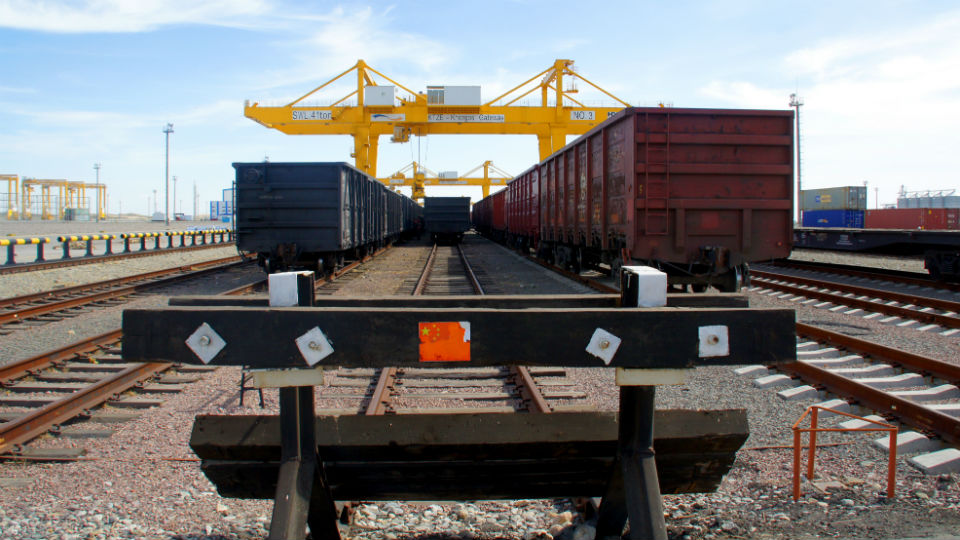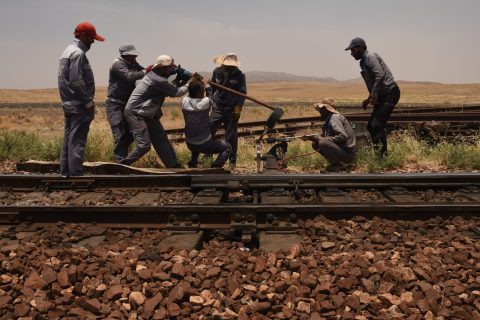Khorgos East Gate: from steppes to high-tech facility

Altynkol Station, on the border between China and Kazakhstan, is fairly quiet. The windows of the brand new station buildings reflect the sun on this warm Monday morning in April. The newly planted perks and trees are in stark contrast to the majestic white peaks in the background. The schedule shows that another freight train from China will arrive this afternoon at 2pm.
It is hard to believe that ten years ago this area inhabited only steppes, without buildings, without a road network, without rails. Nowadays you drive from Almaty to Khorgos on the border with China in three hours via a modern highway, a journey that certainly took twice as long on the old bumpy road. From Khorgos there is a rail connection to the south (Almaty region and Uzbekistan), to the Caspian Sea (Aktau) and to Russia, a route often followed by the European flow of goods.
Leading role for Kazakhstan
In September 2013, Chinese President Xi Jinping first outlined his plans regarding the Belt and Road Initiative (BRI – a trillion-dollar initiative to connect China with Western Europe) in a speech during his visit to Kazakhstan. And the Kazakhs are proud of that! For them it is proof that their country plays a crucial role in the further development of the New Silk Road. Not only as a transit country, but also as a home for foreign companies that want to trade with other countries in Central Asia.
The infrastructure development programme Nurly Zhol, which was launched earlier under the Kazakh flag, became an official part of the Chinese Belt and Road Initiative in 2016. Prior to that, around 8,000 km of road network had been built or repaired in Kazakhstan and 3,200 km of water pipes and heating networks installed.
From steppe to dry port
Khorgos Gateway is the flagship of all the BRI projects in Kazakhstan, which was created entirely with Kazakh money. With the help of 4,000 people, 5,000 pieces of equipment and 90 million m³ of sand, uncultivated steppe soil has been transformed into a fully furnished border area in recent years.
The area includes transshipment facilities to transfer the containers from the narrower Chinese rail to the slightly wider Kazakh rail, with a customs office, container yards with modern cranes, terminals, reefer installations, warehouses, grain silos and even an entirely new city -Nurkent – where employees and their families can live for free.
Digital silk route
Two hours before the arrival of the freight train from China, the staff at Altynkol Station received a digital pre-advice. It describes the load and final destination of each container. “A major step forward”, said chief engineer Maksat Mambetkulov. “It shortens our handling time for a train from 10 hours to just 3 hours and 55 minutes.”
In the first quarter of 2019, 181 freight trains arrived from China at this station (compared to 140 trains in the first quarter of 2018). Final destinations varied from Germany (67 trains) to Russia (4), from Poland (63) to Afghanistan (3), from Central Asia (42) to the Middle East (2).
Khorgos East Gate
The trains that arrive via Altynkol station continue on their way to Khorgos East Gate, just a few kilometers away. “This is where east meets west”, an enthusiastic Hicham Belmaachi shouts, pointing to the two railway gauges that brotherly lie next to each other in the Special Economic Zone (SEZ). He is the COO of Khorgos East Gate, which has been under development since 2011. This inland terminal (which will reach its full capacity in 4 to 5 years making it the largest Dry Port in Central Asia) is equipped with modern facilities for the transfer of goods from one gaugeto the other, but also for the transfer of train to truck and vice versa.
There is also a logistics zone (225 ha) and an industrial zone (224.4 ha) in development. The first distribution centre of 20,000 m² will become operational in May 2019. “Companies can temporarily store their goods here and prepare them for their final destination, for example by putting labels in clothing”, says Belmaachi. “In addition to these Value Added Logistics opportunities, this is all customs territory. For goods that are temporarily stored here, no import duties have to be paid. That only happens when the goods arrive at the final destination.”
More direct routes
Khorgos East Gate functions as a main hub. “Previously, all containers crossing the border remained on the train. Thanks to these new facilities we can sort cargo per destination, even if it is spread over several trains. In this way, we can create a growing number of direct routes from Khorgos. We can run train services much more regularly, which is crucial for a reliable supply chain. Moreover, we work here with modern IT systems, we can track containers and inform customers about arrival times. This is how the flow of goods is becoming increasingly transparent”, says Belmaachi.
90 per cent of the land in the logistics zone has now been allocated to investors: more than 80 per cent internationally (of which the majority from Europe and Dubai), and a small 20 per cent representing medium and small companies from Kazakhstan itself. They benefit, among other things, from the large silos on the special grain terminal, where local farmers can store their products or have them processed into animal feed. These are transported from Khorgos to nearby West China, where a large market is within reach.
Investing tax-free
Investors enjoy great benefits here. Companies do not pay taxes until 2035 and can lease the land for free. This year five logistics development projects are to be completed at at Khorgos East Gate, followed by another 12 in the period up to 2023. Until now, this development has created around 600 permanent jobs. The expectation is that this will be 3,000 in 2023 and 10,000 jobs by 2030.
Kazach Invest is a government agency that assists companies during the entire investment process, from a first idea to implementation, completely free of charge. Deputy Chairman Marat Birimzhan emphasises that for many companies it is not just about the Kazakh market of 18 million people. “Kazakhstan is much closer to West China than the production cities of East China.”
“Around 300 million people live in West China alone”, Birimzhan continues. “Add to that another 180 million inhabitants of the CIS countries in the Eurasian Customs Union (EACU), with which import duties can be traded free of charge. Plus the 56 million inhabitants from the other southern Asian countries. Kazakhstan is a platform, from which a huge market with a growing middle class is within reach. That, in combination with the many tax benefits that we offer makes it very attractive for investors.”
Author: Dianne Huijskens
You just read one of our premium articles free of charge
Want full access? Take advantage of our exclusive offer





